We like to share product recommendations with you and hope you like them! Just to make you aware Water Filter Data may collect a small share of sales or other compensation from the links on this page.
On the question – “Do all water softeners need a drain?”, the simple answer is yes!
Because there are different types of water filters that can help act as water softeners for your house that help prevent scaling in your pipes with no need for a drain.
That is the very small category of water softeners since all other types need drains and drain hoses to work. Make sure it is all installed properly.
The wrong setup or misunderstanding of how water softeners need drains can cause problems and added costs that no one wants.
We will explain in further detail and shed some light on frequently asked questions about water softeners systems with the drain lines, the drain, and the air gap.
Check out this guide and review for the best water softener in 2021!
Starting with the basics and what you should lookup for.
Is Your Water Softener Installed Correctly?
Missing ground clamp
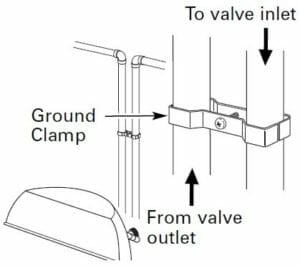 All of the metallic water distribution pipes in the home are supposed to be connected, in other words, If the water pipes in the home weren’t connected, what would happen if an energized (a.k.a ‘hot’, a.k.a ‘ungrounded’) wire came in contact with one of the pipes?
All of the metallic water distribution pipes in the home are supposed to be connected, in other words, If the water pipes in the home weren’t connected, what would happen if an energized (a.k.a ‘hot’, a.k.a ‘ungrounded’) wire came in contact with one of the pipes?
All of the plumbing fixtures and other pipes that were connected would become silently energized. When everything is properly bonded and there is a proper ground jumper at the water meter, this can’t happen.
We find this connection compromised by a plastic by-pass valve at nearly half of the water softeners we see. If the water softener manufacturer provides a plastic by-pass valve, they will also provide a ground clamp that needs to be installed on the water pipes coming in to and going out of the water softener.
If you don’t have the clamp, don’t worry. You can achieve the same thing with a pair of ground clamps attached to the water pipes and a bare copper wire running between them.
Improper drain hose
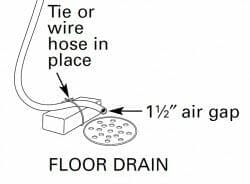 The drain hose that comes from the water softener needs to terminate in a manner that won’t create a potential cross-connection between the potable water and anything else, such as sewer water.
The drain hose that comes from the water softener needs to terminate in a manner that won’t create a potential cross-connection between the potable water and anything else, such as sewer water.
This is usually achieved with an air gap. This is just a literal gap between the end of the discharge pipe and the drain receptor, whether it’s a floor drain, standpipe, or laundry sink.
Softened water provided to the outside faucets
This isn’t technically a defect, it’s bad practice to run softened water to the outside faucets. Lawns and plants don’t need softened water, and this is a tremendous waste of softened water.
Any time a water softener is installed, the water supply pipes for the outside faucets should be connected upstream of the water softener.
It’s also standard practice to connect the cold water for the kitchen sink upstream of the water softener. The reason for this is that softened water will have a higher sodium content – but probably not enough to make much of a difference,
Powered by an extension cord
This is probably the biggest defect that we find with water softeners.
Everyone knows that extension cords aren’t supposed to be used as a substitute for permanent wiring. If an outlet is needed, it should be installed by an electrician.
Why Does a Water Softener System Need a Drain Hose/Line?
A drain hose or line is required to properly take care of the spent water that is being discharged. It allows for the water to go to a drain without issues arising and allows for less maintenance.
Without a drain hose/line you will have problems with discharge and overflow. The drain hose is how the spent water (brine) from the water softener can be discharged without issues arising.
If you were to only have a water line feeding hard water to the water softener, you would have either water overflow all over your floor or water line issues. Waterline issues would occur because of spent water trying to go back into the hard water line potentially.
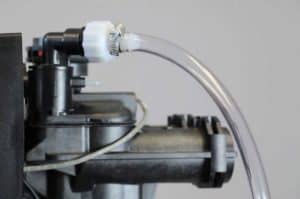
What Happens if the Softener Drain Line is Blocked?
Think about your water softener. You need to flush out all the crud you’ve collected in the tank, but the drain line has collapsed. What was once a ½” line, is now ⅛”.
Over time, dirt and excess hardness, and iron will begin to plug up your water softener resin. Once damaged, the resin is very expensive to replace, and you end up with a huge water softener repair bill.
If a drain line becomes severely restricted, it can actually blow off the softener during regeneration and cause a massive flood!
Type of Drain Required
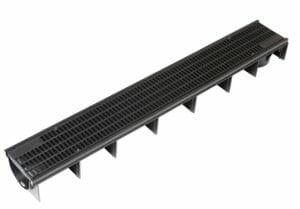 When getting a drain and drain line setup, there are some specifics to keep in mind to have it run smoothly.
When getting a drain and drain line setup, there are some specifics to keep in mind to have it run smoothly.
The drain line size that is considered the best practice would be a ½” polypropylene drain pipe.
To go along with this, the best drain options will be a laundry tray, a floor drain, or a properly trapped outlet (an example would be a dry well in the lawn).
Make sure to check local laws if there are restrictions on drains you can use.
Laundry Tray
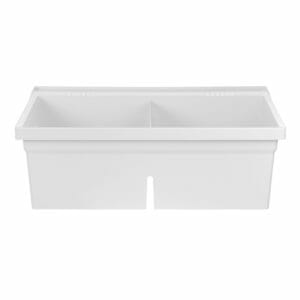 This is what some will call a utility sink, laundry tub, etc.
This is what some will call a utility sink, laundry tub, etc.
When draining into a laundry tray, it functions as an air gap for you to where you do not need the air gap anymore.
It is versatile and useful for other reasons as well and not just for use as a drain for water softeners.
If you have space and time, it may be worth looking into getting a laundry tray installed.
Floor Drain
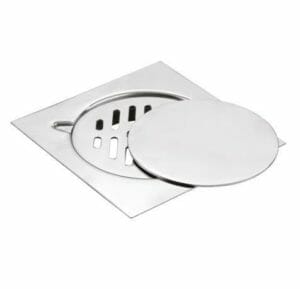 If you have a floor drain, then this is the most common drain that people will drain the water softeners into.
If you have a floor drain, then this is the most common drain that people will drain the water softeners into.
You will need to check codes for your local area to make sure it is allowed, unfortunately. This is due to most of them going to sewer systems.
And if they do not go to sewer systems, they can go to sump pumps, waterways that go to the ground outside, etc.
It depends on how the water systems have been built in your cities and neighborhoods.
Properly Trapped Outlets
If you are tying directly to an outlet instead of having a drain line, you will need a properly trapped outlet (commonly known in plumbing as p-traps).
This is to keep sewer smells or anything from coming backward in the plumbing. For outlets, you can tie it to a sewer line or create a dry well in the yard with a p-trap.
If using a dry well for the trapped outlets it would need to be under the freeze line (if applicable for your area) and need to be big enough storage capabilities for estimated weekly water output.
This means if you have a system regenerate once a week at 50 gallons of water used, you will need to have at least a 55-gallon drum if not two, to ensure the water has time to leach into the ground between uses.
The last thing you will need to do is get a soil test. This is to make sure that it is not going to be put into clay soil, or gets put deep enough so that it is able to leach water into the ground properly.
Where Do I Drain My Water Softener?
For draining your water softener, you will be looking at a couple of different options.
These options do limit where you are able to have the water softener because of regulations in most areas to protect a community’s water from getting contaminated.
The locations to drain them will be a floor drain, a washing machine, a utility sink, or a sump pit.
Keep in mind if you drain it into a sump pit it can void warranties on your sump pump.
How to Install a Water Softener Drain Line
When you are installing a drain line for a water softener, you will need to have two lines.
The first one will be installed on the control valve so that the backwash water is disposed of during the regeneration cycle.
When that line is finished being installed, you will want to connect the other tube to the brine tank and led to the drain that is being used for the water softener.
This line will serve as an overflow drain.
They will both be sent to the same home drain but make sure not to have them directly connected. Otherwise, that would defeat the purpose of having them separate.
Do All Water Softeners Need a Drain: Summary
Not all water softeners require a drain, but ones that do not act more like filters than softeners.
This means water softeners will require a drain, and with that comes rules and regulations for how drains and drain lines can be set up.
Some areas will allow for discharge in septic systems; some will not. If not, your best options are floor drains, a sump pit, a dry well in your yard outside, or the laundry tray.

Wayne is a water quality expert – The founder of Water Filter Data. He has a degree in microbiology and his field of expertise is drinking water. His goal is to allow for clean and healthy water for as many people as possible.



